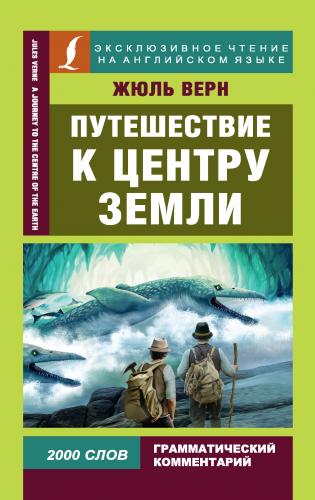He was a tall man, of an iron constitution, and with a fair complexion. His restless eyes were in incessant motion behind his spectacles. His long, thin nose was like a knife blade.
He lived in his own little house in Königstrasse[3], a structure half brick and half wood[4]. My uncle was tolerably rich for a German professor. The house was his own, and everything in it: his god-daughter Gräuben[5], a young girl of seventeen, Martha[6], and myself. As his nephew and an orphan, I became his laboratory assistant. The blood of a mineralogist was in my veins, and in the midst of my specimens I was always happy.
2
One day I came to his study. It was like a museum. Specimens of every kind lay there in their places in perfect order, and correctly named, divided into inflammable, metallic, and lithoid minerals[7].
My uncle was sitting in a velvet armchair, and was looking at a book with intense admiration.
“Here’s a remarkable book! What a wonderful book!” he was exclaiming. “Don’t you see? I have got a priceless treasure, that I found this morning in the bookshop.”
“Magnificent!” I replied, with a good imitation of enthusiasm.
Why worry about this old, bound in rough calf, yellow, faded volume?
“See,” the Professor went on. “Isn’t it a beauty? Yes; splendid! Did you ever see such a binding[8]? Doesn’t the book open easily? Yes; it stops open anywhere. But does it shut equally well? Yes; for the binding and the leaves are flush. And look at its back, after seven hundred years!”
I asked a question about its contents, although I did not feel the slightest interest.
“And what is the title of this marvellous work?” I asked.
“This work,” replied my uncle, “this work is the Heims Kringla [9]of Snorre Turlleson[10], the most famous Icelandic author of the twelfth century! It is the chronicle of the Norwegian princes who ruled in Iceland.”
“Indeed;” I cried, “and of course it is a German translation?”
“What!” sharply replied the Professor, “A translation! What can I do with a translation? This is the Icelandic original!”
“Ah!” said I; “and is the type [11]good?”
“Type! What do you mean by the type, wretched Axel[12]? Type! Do you take it for [13]a printed book, you ignorant fool? It is a manuscript, a Runic manuscript.”
“Runic?”
“Yes. Do I need to explain what that is?”
“Of course not,” I replied in the tone of an injured man. But my uncle continued.
“Runic characters were in use in Iceland in former ages. They were invented, it is said, by Odin [14]himself. Look there, and wonder, impious young man, and admire these letters, the invention of the Scandinavian god!”
Well, well! I was going to prostrate myself before this wonderful book, when a little incident happened to divert conversation into another channel. A dirty slip of parchment slipped out of the volume and fell upon the floor.
“What’s this?” cried my uncle.
And he laid out upon the table that piece of parchment, five inches by three[15], with certain mysterious characters.
The Professor raised his spectacles and pronounced:
“These are Runic letters; they are exactly like those of the manuscript of Snorre Turlleson. But what is their meaning? It is certainly old Icelandic.”
Suddenly two o’clock struck by the little clock over the fireplace. At that moment our good housekeeper Martha opened the study door, and said:
“Dinner is ready!”
I followed her, and sat in my usual place. I waited a few minutes. Professor did not come. He had never missed the important ceremonial of dinner.
“I have never known such a thing,” said Martha. “Mr. Liedenbrock is not at table! Something serious is going to happen.”
After the dinner, I came back to the study.
3
“Undoubtedly it is Runic,” said the Professor; “but there is a secret in it, and I want to discover the key.”
He finished the sentence with a violent gesture.
“Sit there,” he added “Sit there and write.”
I sat down.
“Now I will dictate to you every letter of our alphabet which corresponds with each of these Icelandic characters. We will see what that will give us.”
The dictation commenced. I did my best. Every letter came one after the other[16], with the following remarkable result:
mm.rnlls esrevel seecIde
sgtssmf vnteief niedrke
kt,samn atrateS saodrrn
emtnaeI nvaect rrilSa
Atsaar .nvcrc ieaabs
ccrmi eevtVl frAntv
dt,iac oseibo KediiI
When this work has ended my uncle tore the paper from me and examined it attentively for a long time.
“What does it all mean?” he asked mechanically.
I could not help him.
“This is what is called a cryptogram, or a cipher,” he said, “in which letters are purposely thrown in confusion. Under this jargon there may lie the clue to some great discovery!”
As for me, I thought that there was nothing at all in it; though, of course, I did not say so.
Then the Professor took the book and the parchment, and diligently compared them together.
“These two writings are not by the same hand,” he said; “the cipher is of later date than the book. There are two hundred years between the manuscript and the document.”
I agreed.
“I can imagine,” continued my uncle, “that some possessor of this book wrote these mysterious letters. But who was that possessor? Is there his name in the manuscript?”
My uncle raised his spectacles, and carefully examined the blank pages of the book. On the front of the second title-page he could distinguish some letters.
“Arne Saknussemm[17]!” he cried in triumph. “That is the name of another Icelander, a savant of the sixteenth century, a celebrated alchemist!”
I gazed at my uncle with admiration.
“Those alchemists,” he resumed, “Avicenna, Bacon, Lully, Paracelsus[18], were the real and only savants of their time. They made discoveries at which we are astonished.
